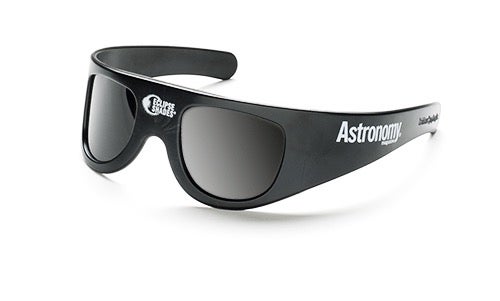
Note: This post contains affiliate links. When you buy a product through the links on this page, we may earn a commission.
As we eagerly anticipate the awe-inspiring total solar eclipse on April 8, 2024, we’re here to help you prepare with the right equipment. Choosing the best way to see the eclipse — whether you plan to watch from home, through the lens of your smartphone, or with a more advanced setup like a telescope — is key to having a memorable time.
The following is a guide to help you safely see the 2024 eclipse. It includes basic eclipse glasses and advanced solar telescopes. We’ve chosen products in this review based on safety, ease of use, and user reviews to ensure you have the best viewing experience possible.
Here are some of the basics followed by our product recommendations.
What is the safest way to view an eclipse?
The safest way to view a solar eclipse is through eclipse glasses that meet the international safety standard ISO 12312-2:2015, which was confirmed in 2020. These glasses are specially designed to block out harmful solar radiation and reduce the Sun’s brightness to a safe and comfortable level. It’s crucial to ensure that your eclipse glasses are not damaged or scratched, as even a small tear can reduce their effectiveness and cause damage to your eyes or equipment.
For those interested in a more immersive eclipse viewing experience, telescopes or binoculars with solar filters are a great option. These filters must be mounted on the front of the device (not the eyepiece) to block the intense sunlight before it enters the telescope. Never use regular sunglasses or unfiltered cameras, telescopes, or binoculars to view an eclipse, as these do not offer adequate protection against eye damage.
Another safe method for seeing a solar eclipse is indirect viewing, such as by using the pinhole projector technique. This DIY method involves projecting the Sun’s image onto a flat surface through a pinhole in a piece of cardboard or similar material. This will allow you to watch the eclipse’s progress without looking directly at the Sun. Just remember, whatever method you choose to view an eclipse, the key is to protect your eyes from the Sun’s intense rays.
What to consider when choosing eclipse viewing equipment
Choosing the right equipment for viewing a solar eclipse is about more than just finding something to darken the bright Sun. The right gear should offer a balance between safety, optical quality, and ease of use. Here are some key factors to keep in mind:
- Safety certification: Look for ISO 12312-2 certification in eclipse glasses and solar viewers to ensure they meet safety standards.
- Optical quality: High-quality lenses and filters provide clearer and more detailed views of the eclipse.
- Compatibility: Ensure that telescope and camera filters are compatible with your existing equipment.
- Comfort and portability: Consider the comfort of wearables like glasses, as well as the portability of telescopes or binoculars.
- Value-added features: Extras like magnification capabilities and included accessories can enhance your viewing experience even more.
In addition to the considerations above, we selected the following products based on extensive research, user reviews, expert opinions, and overall value for money. We also prioritized safety and optical quality to ensure you have the best eclipse viewing experience possible.
Here is our guide to the best equipment to safely view a total solar eclipse.
Astronomy Eclipse Shades Wrap-Around Eclipse Glasses

- Features and benefits: With a wraparound design, these plastic glasses block more than 99.9 percent of the Sun’s rays and meet ISO 12312-2 safety standards. They also come with a pouch and lanyard for storage and carrying.
- What to keep in mind: The wraparound design may not fit small heads or over prescription glasses.
- Why we recommend it: These are ideal for those looking for more secure-fitting glasses that offer comprehensive protection and a crisp view of the eclipse.
- Price: $19.95
Celestron EclipSmart 2x Power Viewers Solar Eclipse Observing Kit
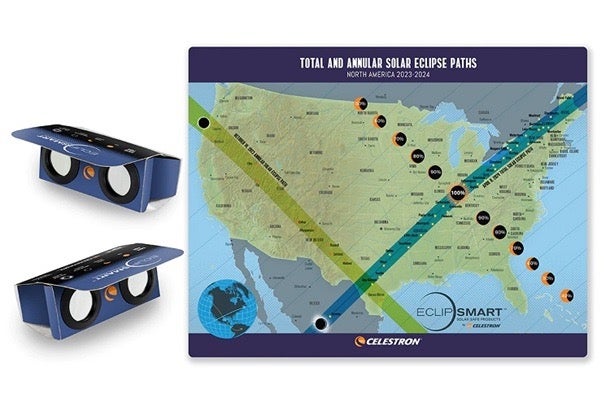
- Features and benefits: This two-pack of viewers offers 2x magnification for a closer look at the eclipse, which is ideal for a more detailed observation.
- What to keep in mind: They do require careful handling due to their shape.
- Why we recommend It: A unique product offering both magnification and protection, these viewers are perfect for those seeking more than standard glasses. And this package also includes a bonus double-sided eclipse transit map poster.
- Price: $12.95
Astronomy Solar Eclipse Glasses (pack of 25)
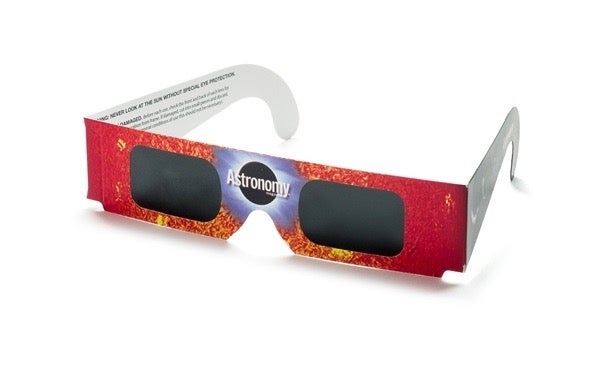
- Features and benefits: These NASA-approved solar eclipse glasses made by Rainbow Symphony include scratch-resistant lenses that provide a sharp solar image with a natural orange color.
- What to keep in mind: Be sure to follow the safety information conveniently printed on the backside of the eclipse glasses.
- Why we recommend it: This affordable bundle of 25 pairs of quality eclipse glasses is perfect for groups of students, family, or friends viewing the solar eclipse.
- Price: $39.95 ($1.60/pair)
Celestron EclipSmart Solar Eclipse Glasses
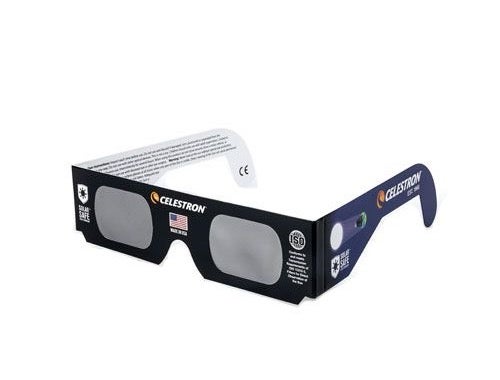
- Features and benefits: These foldable solar eclipse glasses are ISO-certified and can accommodate many head sizes.
- What to keep in mind: As with any pair of eclipse glasses or solar filters, always be sure to check the lenses for scratches, and discard the pair if damage is present.
- Why we recommend it: Affordable and easy to use, these simple glasses will provide you with the quality you need to safely enjoy the eclipse.
- Price: $2.95
Celestron 50mm EclipSmart Solar Telescope with Backpack
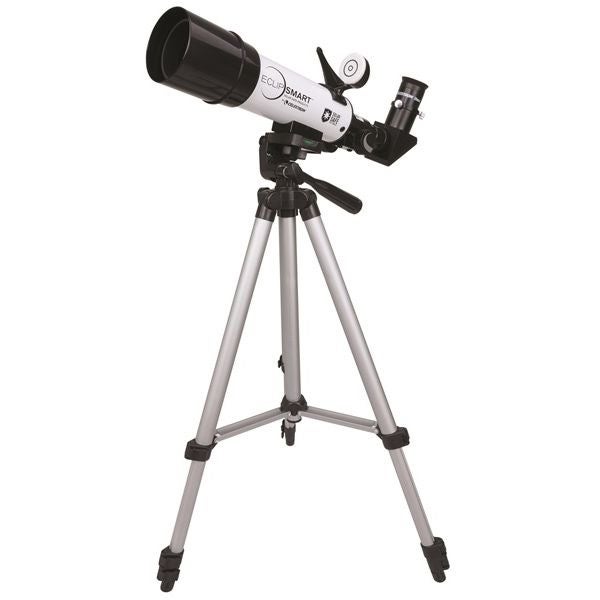
- Features and benefits: This telescope offers 18x magnification, a 2-inch (50mm) aperture, and comes with a non-removable solar filter, making it ideal for solar observations.
- What to keep in mind: It’s a more advanced option for those looking for impressively detailed views of the eclipse.
- Why we recommend: This telescope is an affordable option for serious enthusiasts who want to take their solar observing experience to the next level.
- Price: $129.95
Coronado PST Personal Solar Telescope H-Alpha Refractor
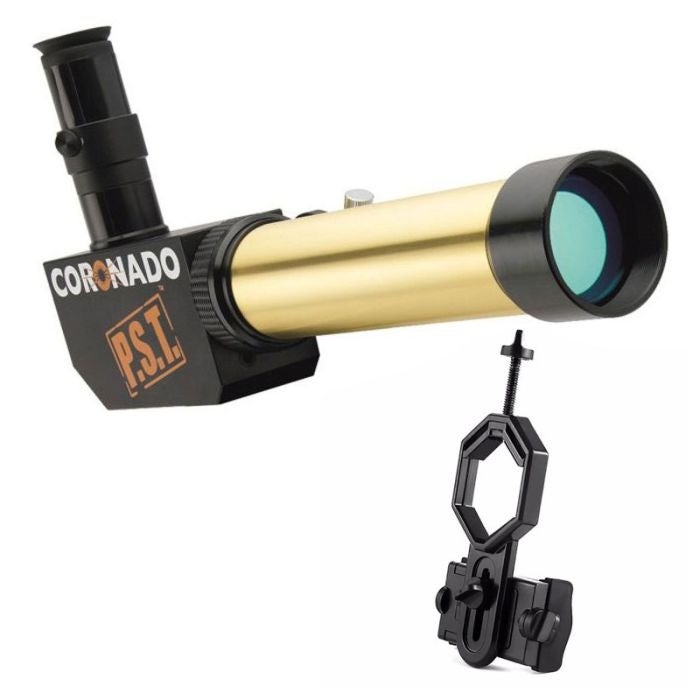
- Features and benefits: This high-quality, highly portable 1.6-inch (40mm) solar telescope is built for observing the Sun in H-alpha light. With it, you can unlock great views of the snake-like filaments and sunspots that dance across the Sun’s surface.
- What to keep in mind: Though an excellent choice for observing the Sun at any time, the H-alpha view may not be what every eclipse viewer is looking for.
- Why we recommend it: This ultra-light (3.2 pounds) and portable telescope is perfect for those who want to unlock unique views of the Sun’s features, both before and after the eclipse.
- Price: $899.99
Best eclipse glasses for the 2024 solar eclipse
Eclipse glasses are essential for safely viewing a solar eclipse, as they are designed to protect your eyes from harmful solar radiation. Fortunately, there are many options out there to choose from. The recommendations below are for eclipses glasses with a strong track record for safety, quality, and comfort.
- Astronomy Eclipse Shades Wrap-Around Eclipse Glasses: These glasses have a comfortable wrap-around design and are both CE and ISO certified. They also come with a lanyard and a microfiber pouch for storing and cleaning.
- Price: $19.95
- Lunt Solar Systems Solar Eclipse Glasses (10-pack): These affordable ISO-certified glasses include high-quality lenses designed to safely filter harmful solar rays.
- Price: $17.95
- Astronomy Solar Eclipse Glasses (5-Pack): These glasses are designed for optimal safety and clarity during solar eclipse viewing. They’re ideal for individuals or small groups planning to experience the eclipse in exceptional clarity.
- Price: $9.95
- Discover Solar Eclipse Glasses (5-pack): Known for their excellent optical quality, these glasses ensure a safe viewing experience. They’re perfect for eclipse enthusiasts who prioritize both safety and visual clarity.
- Price: $9.95
Best magnified viewers to see the 2024 eclipse
What’s better than getting a clear, safe view of a solar eclipse? Getting a magnified view of that eclipse, of course! Below is our top pick for an affordable pair of magnifying eclipse viewers.
- EclipSmart 2x Power Viewers Solar Eclipse Observing Kit: A unique product with sturdy plastic lenses that offer 2x magnification for a closer look at the eclipse. This package also includes a double-sided eclipse map poster.
Note: No matter what equipment you choose to bring to the 2024 total solar eclipse, remember that using certified eclipse glasses or viewers is crucial to preventing damage to your eyes.
Frequently Asked Questions (FAQs)
What are the different kinds of eclipses?
Eclipses are celestial events where the Sun, Earth, and Moon align – and they come in various forms.
A solar eclipse occurs when the Moon passes between Earth and the Sun, obscuring the Sun from Earth’s view.
- During a total solar eclipse, the Moon completely covers the Sun, briefly turning day into night.
- An annular solar eclipse is a type of solar eclipse that happens when the Moon covers the Sun’s center, leaving a thin “ring of fire” visible.
- A partial solar eclipse occurs when the Moon’s alignment with Sun means the Moon only covers a fraction of the solar disk, leading to a crescent-shaped view of the Sun.
Unlike a solar eclipse, a lunar eclipse, occurs when Earth comes between the Sun and the Moon, casting Earth’s shadow on the Moon’s surface. Since these do not involve the Sun’s disk, no eye protection is required when viewing a lunar eclipse.
Can I use regular sunglasses to view an eclipse?
No! Regular sunglasses are not suitable for viewing a solar eclipse because they completely lack the necessary filtering capabilities required to protect your eyes from the Sun’s intense rays. For reference, eclipse sunglasses that meet the ISO 12312-2 standard for safe eclipse viewing block about 100,000 times more light than standard sunglasses.
How can I safely take a good picture of the eclipse?
Capturing a solar eclipse with a camera demands careful planning. First, a solar filter is essential to protect your camera’s sensor and ensure a clear image. Using manual settings is best, as it allows you to adjust exposure during the eclipse’s different phases. Utilizing a tripod will also help you steady the camera and reduce blur, and using a remote shutter or timer will help minimize shake.
A telephoto lens is useful for zooming in, but be mindful of your exposure time to avoid overheating the camera. Also be sure to practice beforehand to familiarize yourself with the settings so you can overcome any challenges you may face during eclipse day.
Can I view an eclipse without buying anything?
Yes. You don’t need equipment to view a solar eclipse. A simple way to view a solar eclipse is using a pinhole projector made with two pieces of paper or cardstock. By creating a small hole in one and letting sunlight pass through it onto the other, you can safely observe the eclipse’s progress. Another option is to utilize natural pinholes, like gaps between leaves, which cast crescent-shaped shadows during an eclipse, offering a unique viewing experience.
Additionally, local community events, often hosted by libraries, schools, or astronomy clubs, typically provide access to safe viewing tools like eclipse glasses – as well as the opportunity to enjoy the eclipse with others.
Where is the best place to see the 2024 eclipse?
For the best view of the 2024 total solar eclipse, you’ll want to be within the path of totality, which sweeps across North America on April 8, 2024. This path is where the Moon will completely blot out the Sun, offering a breathtaking view of the total eclipse. Being in this path is crucial for the full eclipse experience, as locations outside of it will only witness a partial eclipse.
For more detailed information on specific viewing sites along the path of totality, you can check out our guide to the 20 best places to view the 2024 total solar eclipse.
When is the next solar eclipse after 2024?
An average of 2.38 solar eclipses occur each year somewhere on the planet. However, a specific location on Earth is only in the path of totality for a solar eclipse about once every 375 years, on average. For those in the Southern Hemisphere, that average jumps up to about once every 540 years, versus about once per 330 years for those in the Northern Hemisphere.
After the 2024 eclipse, the next total solar eclipse will occur on August 12, 2026, and it will be visible from the Arctic, Greenland, Iceland, Spain, and Northeastern Portugal. Following that, on August 2, 2027, a total eclipse will be visible in parts of North Africa, the Middle East, and Central Asia.
As you prepare for this year’s total solar eclipse across North America, remember that whether you’re a seasoned astronomer or just beginning your journey into eclipse viewing, the right equipment can make all the difference. Happy eclipse chasing!









